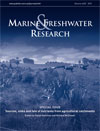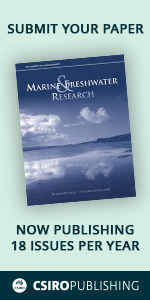
Marine and Freshwater Research
Volume 64 Number 5 2013
Sources, Sinks and Fate of Nutrients from Agricultural Catchments
MF12097Uncertainties in estimated phosphorus loads as a function of different sampling frequencies and common calculation methods
Many lakes and rivers are badly affected by algal blooms, which are often caused by phosphorus pollution. This study compares different ways of estimating phosphorus inputs to our waterways and highlights the large amount of uncertainty generated by different methods of sampling and data interpretation. In general, high frequency monitoring is needed to implement and manage nutrient reduction programs effectively.
MF12097 Abstract | MF12097 Full Text | MF12097PDF (582 KB) Open Access Article
MF12153Establishment of reference or baseline conditions of chemical indicators in New Zealand streams and rivers relative to present conditions
Reference conditions exhibit natural concentrations of chemical indicators of water quality and therefore can be used to determine the anthropogenic input. Using data from > 1000 water quality sites, a method was developed to estimate median concentrations of chemical indicators under reference conditions for New Zealand streams and rivers and account for natural variation in climate, hydrology and geology as classified by the River Environment Classification (REC). By incorporating natural variation, reference conditions can then be used to help inform water quality objectives and avoid setting water quality limits or targets that are either too restrictive, and impossible to meet (e.g. below reference conditions), or too high, such that they have little ecological benefit.
MF12153 Abstract | MF12153 Full Text | MF12153PDF (696 KB) Open Access Article
MF12155Trends in water quality of five dairy farming streams in response to adoption of best practice and benefits of long-term monitoring at the catchment scale
Inputs of nitrogen, phosphorus, sediment and faecal matter from dairy farming are a major cause of degraded water quality. Results from a monitoring study of five dairy catchments and their streams showed that increased fencing of streams to keep cattle out, and greater use of effluent irrigation of markedly improved water quality. Monitoring periods of at least 10 years are necessary to detect such changes.
MF12155 Abstract | MF12155 Full Text | MF12155PDF (604 KB) Open Access Article
MF12166Drivers of long-term trends and seasonal changes in total phosphorus loads to a mesotrophic lake in the west of Ireland
High levels of nutrients have caused algal blooms in Lough Leane, Ireland, an important tourist location. Investigations of nutrient sources found that although agriculture provided more nutrients annually, the local Wastewater Treatment Plant played a crucial role in phosphorus loading during summer, when river discharge was low. Managers need to take account of such seasonal differences when targeting causes of blooms.
MF12166 Abstract | MF12166 Full Text | MF12166PDF (404 KB) Open Access Article
MF12164Convergence of agricultural intensification and climate change in the Midwestern United States: implications for soil and water conservation
US agriculture is vitally important to world food supplies, but needs to improve environmental performance under a changing climate while intensifying production. This review highlights healthy functioning soil as being critical to ensure U.S. agriculture's resilience under these converging pressures. Reversing soil degradation will accrue wide benefits for agriculture and for the quality of freshwater and marine resources.
MF12164 Abstract | MF12164 Full Text | MF12164PDF (838 KB) Open Access Article
MF12128Effects of nutrient loading on the trophic state of Lake Brunner
Enhanced nutrient loading by farming activity often causes eutrophication in shallow lakes in lowland areas but can also affect water quality in large and deep lakes. In Lake Brunner, a large and deep nutrient poor lake, nutrient concentrations and algal biomass have increased since 1992. These observations are likely to have resulted from enhancement of pasture drainage and effluent inputs from expanding dairy farms.
MF12128 Abstract | MF12128 Full Text | MF12128PDF (845 KB) Open Access Article
MF12296Managing pollutant inputs from pastoral dairy farming to maintain water quality of a lake in a high-rainfall catchment
Managing dairy runoff in high rainfall areas is challenging. In this study, we characterise loads and concentrations in a small dairy catchment stream entering an oligotrophic lake and identify mitigation opportunities. Key loss pathways were drainage to groundwater and surface runoff in storms, and best management practices included reducing losses of fertiliser P, better management of dairy farm effluent and managing stock during winter (wintering).
MF12296 Abstract | MF12296 Full Text | MF12296PDF (767 KB) Open Access Article
MF12141A Bayesian Belief Network approach to evaluating complex effects of irrigation-driven agricultural intensification scenarios on future aquatic environmental and economic values in a New Zealand catchment
Sustainable development is enhanced by tools that predict effects on a wide range of economic, social and environmental values. We developed a computerised ‘knowledge network’ to predict the likely states of key values in response to development scenarios involving irrigation-driven intensification of farming, on-farm pollution control measures, and dam location. The approach has assisted catchment management planning locally and has wider potential use.
MF12141 Abstract | MF12141 Full Text | MF12141PDF (1.1 MB) | MF12141Supplementary Material (303 KB) Open Access Article
MF12106Assessing ways to combat eutrophication in a Chinese drinking water reservoir using SWAT
In China, rapid development in population and economy has led to environmental degradation to an extent that currently jeopardises the quality of water resources. We linked a complex watershed-model with an empirical water quality model for a Chinese drinking water reservoir. Results suggest that point sources and diffuse pollution are equally important in the degradation of surface water quality, and display how a series of management interventions may improve water quality.
MF12106 Abstract | MF12106 Full Text | MF12106PDF (1.4 MB) Open Access Article



